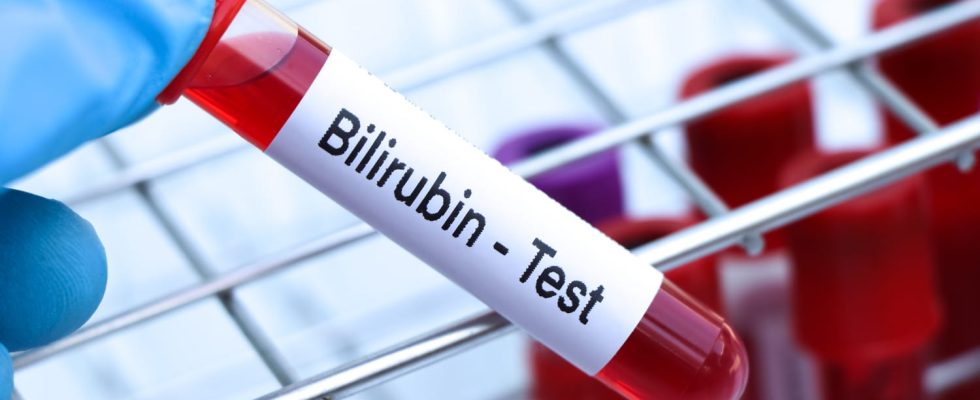The measurement of the level of bilirubin in the blood makes it possible to evaluate the functioning of the liver. High bilirubin can indicate a liver problem. It can also be abnormally low in certain circumstances. Analysis decryption.
Definition: what is bilirubin?
Bilirubin comes from destruction of hemoglobin from red blood cells in the spleen. It’s a yellow pigment causing urine color and stools. It circulates in the blood, bound to a protein, albumin, then is captured by the liver and is excreted in the bile. Bilirubin exists mainly in 2 forms which are “unconjugated” or “conjugated”. Free or “unconjugated” or even “indirect” bilirubin, which is toxic because it is not soluble in water, is transported by albumin to the liver where it is “conjugated” with glucuronic acid and then eliminated in faeces and urine. Most bilirubin in the blood is unconjugated.
Blood test
There blood bilirubin measurement helps to assess the proper functioning of the liver. Bilirubin assays are primarily used for diagnosis of liver diseases, detection of haemolytic anemia and assessment of the severity of jaundice (yellow discoloration of the tissues due to bilirubin deposits). The dosage is done through a blood test.
What is the normal total bilirubin level?
The normal value for total bilirubin is at birthbetween 8 – 25 mg / L, at the 1st week, between 25 – 120 mg /L, at the 2nd week, between 10 – 110 mg /L, at the 3rd week, between 6 – 30 mg /L and at the 4th week, between 3 – 15 mg /L. From 1 month and in adulthood, it is between 3 -10 mg/L. THE values are higher in humans and we observe a gradual decrease in levels during the first 2 trimesters of pregnancy. Results may potentially vary depending on the technique used by the laboratory.
Why is bilirubin high?
The bilirubin level may increase, this is called hyperbilirubinemia. A increased blood level of conjugated bilirubin is a marker of poor liver function. On the other hand, an increase in free bilirubin does not suggest liver disease, and can be found without any pathological reason. Hyperbilirubinemia can be caused by:
- Hemolysis (increased destruction of red blood cells),
- THE Gilbert’s syndromebenign genetic disease causing an increase in the level of bilirubin,
- A hepatitis or biliary constriction.
- Above 30mg/l, the skin and eyes turn yellow due to too high a concentration of bilirubin: this is jaundice. It gives the skin a yellowish color. It is caused by a buildup of bilirubin in the blood.
- Too high a level or a sudden increase in bilirubin in the blood may suggest abnormal destruction of red blood cells, hepatitis or liver cirrhosis. Jaundice is usually due to increased blood levels of free bilirubin, but some rare genetic jaundice is related to conjugated bilirubin.
- Conjugated bilirubin sees its rate increase in case cholestasis, that is, during stagnation of bile in the bile ducts. An increase in the level of direct bilirubin can also be observed in the case of a hepatic anomaly, biliary obstruction, viral hepatitis, Dubin-Johnson syndrome or even Rotor syndrome.
- Increased bilirubin can be seen in newborns due to liver immaturity. We will then talk aboutneonatal jaundice. This disappears in about 5 days.
Why is bilirubin low?
The bilirubin level can decrease in certain exceptional cases such as during the first two trimesters of pregnancy without this being pathological.
When to consult? When to worry?
Bilirubin is rarely measured on routine checkups. It is important to consult in case of appearance of a yellowish complexion or when the conjunctiva turn yellow. The dosage of bilirubin will be prescribed at the slightest doubt of hepatic or gallbladder dysfunction.
Should I take treatment to lower my bilirubin?
The treatment of hyperbilirubinemia is primarily the treatment of its cause. “In case of increased bilirubinemia, it is necessary to limit alcohol consumption, of be careful when taking certain medicationsto have a diet adapted to liver disorders“ recommends Dr Anne-Christine Della Valle, general practitioner. There Gilbert’s disease does not require any treatment, it is always benign and develops in flare-ups, which resolve spontaneously. I’newborn jaundice, if it does not disappear, it must be treated with phototherapy. The management of hepatic and gallbladder diseases is specific.
Thanks to Dr Anne-Christine Della Valle, general practitioner.
